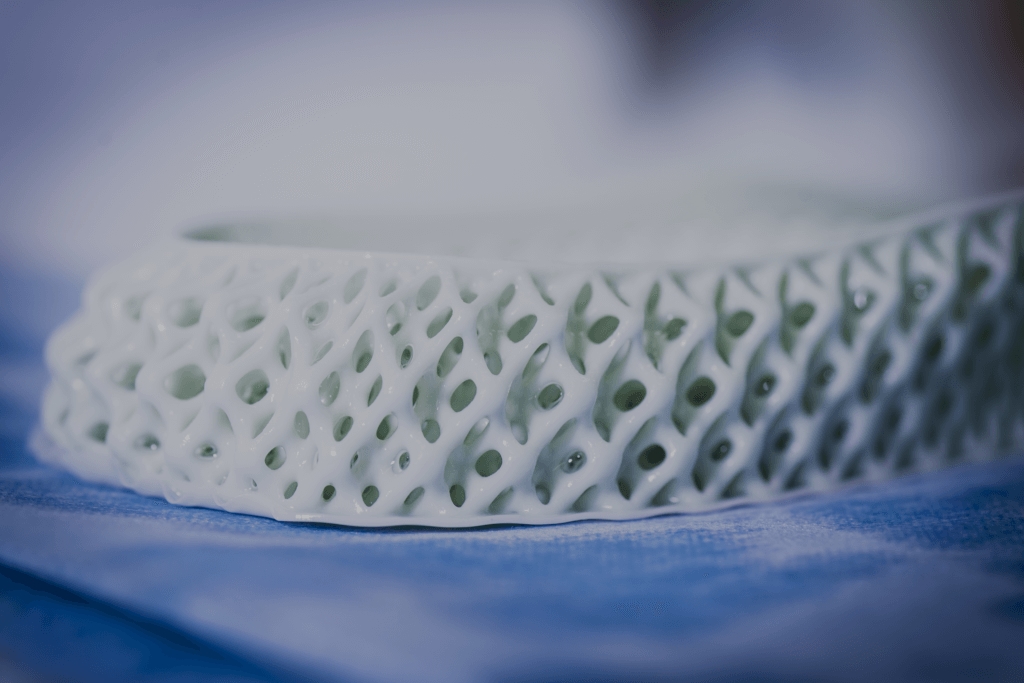

Previously published on fastradius.com on April 17, 2020
In the world of manufacturing, “complex geometries” refers to parts with three-dimensional designs with features such as undercuts, hollow spaces, or intricate internal structures. Complex geometries can mirror rounder, more organic structures, which historically has made them extremely difficult or expensive to create using traditional manufacturing methods like casting, CNC milling, or CNC turning, all of which rely on straight tools to remove material.
The workaround has been to create parts with multiple components that, once manufactured, are fastened together. These additional steps in the manufacturing process can quickly drive up the cost of production, as well as the cost per part when it goes to market.
However, additive manufacturing processes are proving to be far more effective means by which to create geometrically complex parts. This is because additive manufacturing methods create pieces by adding material one layer at a time, enabling engineers and designers to produce parts with involved geometries — even those with open interior spaces — as a single piece.
Because additive processes create parts from scratch using materials in a constitutive state, like a liquid or powder — rather than from a block of material — parts with complex geometries can be created with increased efficiency, often in a single operation.
As such, a number of markets now rely on additive manufacturing to produce geometrically complex parts. The FAA approved the first 3D printed part for commercial use in jet engines in 2015, and since then, the aerospace industry has taken advantage of additive’s ability to efficiently manufacture rocket injectors, fuel nozzles, and other structural components in ways that increase the strength of the part while also reducing its overall weight.
Certain medical implants and devices can also be produced more efficiently and cost-effectively using additive manufacturing. Some joint replacements, such as artificial knees and hips, make use of complex lattice structures to promote osseointegration — designs that would be highly inefficient if not impossible to create using traditional manufacturing methods.
Devices requiring tubing to transport air or fluids can also be produced through additive processes, eliminating the need for excess tubing and valves by combining multiple components into a single part. Such processes cut on costs, time, and resources required to produce medical devices and products.
To manufacture viable, high quality parts with complex geometries, engineers must assess several key factors, including the production method, costs of production, and design optimization.
Traditional methods of manufacturing are subtractive, meaning that tools are used to remove material from a workpiece to shape the part or component. As such, there are certain inherent restrictions in terms of the types of parts that can be created.
Using traditional methods, the time required to cut intricate geometries from blocks of material is directly related to the cost of production, something that’s especially true for metal parts, which tend to have longer production cycles.
The advantage of additive manufacturing processes is that they upend the notion that geometric complexity inherently means increased cost. In fact, the exact opposite is true: because 3D printing creates parts from scratch, less material is lost as waste when manufacturing a complex geometry, which translates to less time in the machine and lower production costs.
The prototyping and testing phases of production for parts with complex geometries tends to be costly when executed through traditional manufacturing methods. However, additive manufacturing often guarantees low individual product cost from the outset, loosening restraints on manufacturers during the design cycle.
Using traditional manufacturing methods for prototyping purposes requires intensive time and cost commitments across the entire design cycle. Additive manufacturing enables designers and engineers to prototype faster and with greater flexibility in terms of design features.
When it comes to creating geometrically complex parts, additive manufacturing is by and large more time-, resource-, and cost-effective than traditional methods. Additive processes accelerate rapid prototyping and end-to-end production times, thereby cutting costs.
At SyBridge, we’re committed to helping our customers make new things possible every day. Our design and development engineering teams are comprised of subject matters experts who work closely with customers during every stage of the manufacturing life cycle, from design through to post-production. If you’re ready to get started, contact us today.
Forget typical cycle times. We're pushing the boundaries of conformal cooling. While traditional approaches deliver…
Forget typical cycle times. We're pushing the boundaries of conformal cooling. While traditional approaches deliver…
From left to right: Brayden Janak (apprentice); Logan Vifaquain (CNC machining, Programming and CMM); Ron…
SyBridge Technologies is proud to announce we have been awarded the 2023 General Motors Supplier…
Today, designers and engineers are accustomed to working with digital tools in their day-to-day jobs.…
Optimizing Your Injection Molding Process for Cost-Effective Manufacturing Excellence In today’s competitive landscape, manufacturers are…